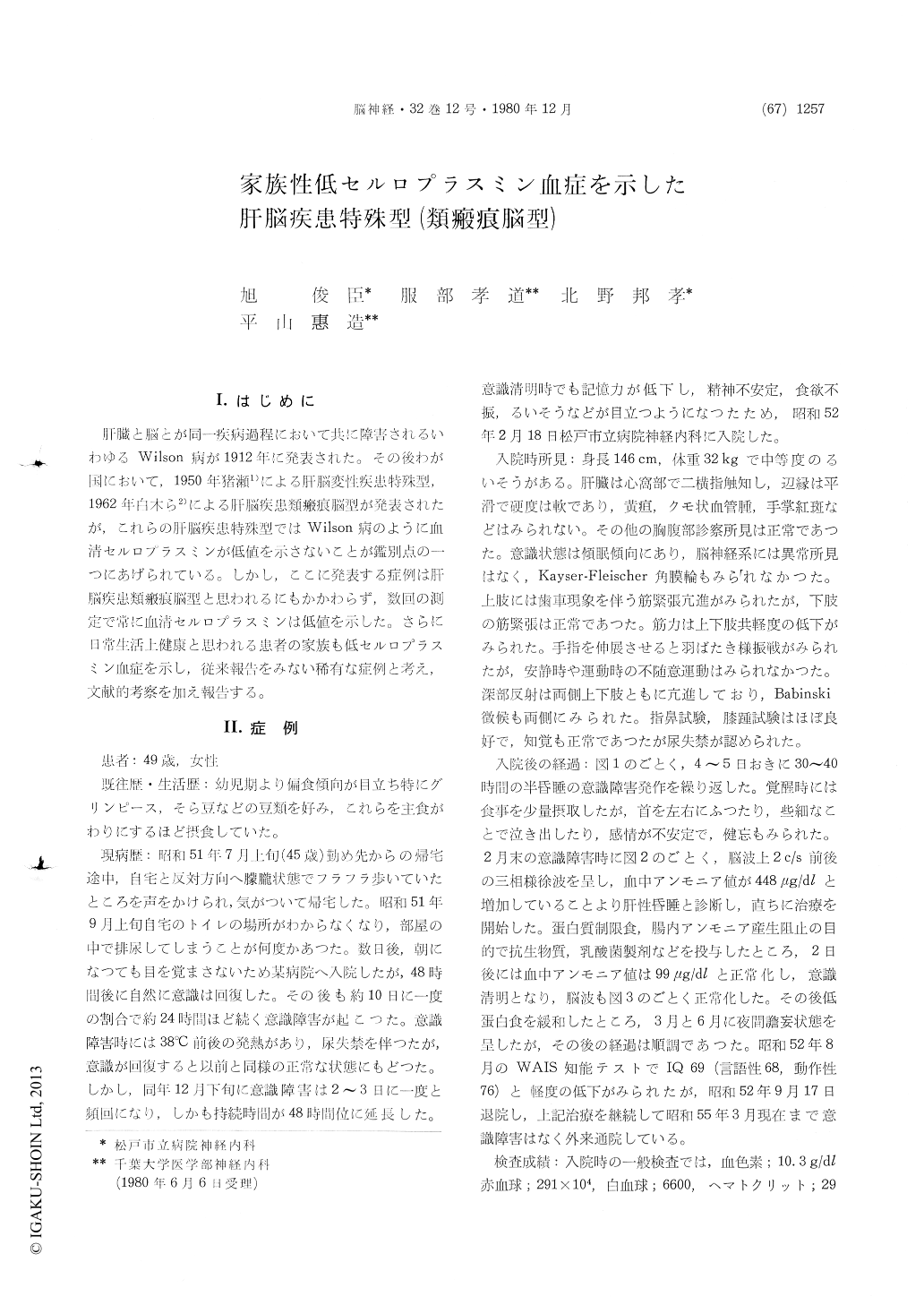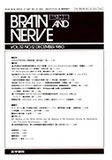Japanese
English
- 有料閲覧
- Abstract 文献概要
- 1ページ目 Look Inside
I.はじめに
肝臓と脳とが同一疾病過程において共に障害されるいわゆるWilson病が1912年に発表された。その後わが国において,1950年猪瀬1)による肝脳変性疾患特殊型,1962年白木ら2)による,肝脳疾患類瘢痕脳型が発表されたが,これらの肝脳疾患特殊型ではWilson病のように血清セルロプラスミンが低値を示さないことが鑑別点の一つにあげられている。しかし,ここに発表する症例は肝脳疾患類瘢痕脳型と思われるにもかかわらず,数回の測定で常に血清セルロプラスミンは低値を示した。さらに日常生活上健康と思われる患者の家族も低セルロプラスミン血症を示し,従来報告をみない稀有な症例と考え,文献的考察を加え報告する。
We reported a case of a 49-year-old woman who had been suffering from a periodic disturbance of cosciousness for over seven months prior to admis-sion to Matsudo Municipal Hospital. The disturb-ance of consciousness lasted for about 24 hours and recurred every 2-10 days in increasing frequency. During the episode she was incontinence of urine. On admission she was in a state of somnolence with pyramidal as well as having extrapyramidal signs. She was a thin emaciated woman with a palpable liver about 4cm below the right costal margin. Laboratory examination during somnolence revealed a high serum ammonia level and triphagic slow waves on the electroencephalogram, which lead to the diagnosis of hepatic coma. She was treated with a low protein diet and oral antibiotics. There-after she has been almost free from the disturbance of consciousness without pyramidal and extrapyra-midal signs. Her serum ceruloplasmin was ab-normally low in a range of 13-17mg/dl (normal is 25-37mg/dl) on repeated examinations. Wilson disease, however, was ruled out because of the normal values of serum copper, urinary copper ex-cretion and a penicillamine overloading test and negative copper deposition on a liver biopsy speci-men. She was diagnosed to have hepato-cerebral disease of pseudoulegyric type rather than Inose type because of no clinical evidence suggesting portal systemic shunt (although an angiography was not performed) and her long history of un-balanced diet of prefering beans.
Unexpectedly, an examination of her family (two sisters, son and daughter) revealed all of them had low serum ceruloplasmin in the range of 18-22mg/dl but other routine laboratory data including serum copper were normal and they were all healthy with a normal neurological examination.
We reviewed various literature and could find only three reports of familial low serum cerulo-plasmin.
Serum ceruloplasmin levels of familial hypo-ceruloplasminenia were in the range of 10-22mg/dl including ours and not as low as seen in Wilson disease.
The cause of familial low serum ceruloplasmin is probably related to the hereditary disturbance of ceruloplasmin metabolism.
In our case, the relationships between the pse-udoulegyric type of hepato-cerebral disease and familial hypoceruloplasminemia was not identified, whether it is related etiologically or an unrelatedcausual occurrence. Further study for ceruloplasmin metabolism is needed to clarify the above relation-ship.
In conclusion, we reported a very rare combina-tion of hepato-cerebral disease of pseudoulegyric type and familial hypoceruloplasminemia.

Copyright © 1980, Igaku-Shoin Ltd. All rights reserved.


